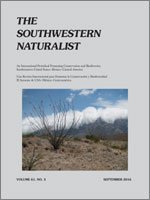In 1956, and again in 1988, breeding pairs of rock wrens (Salpinctes obsoletus) were observed in Churchill, Manitoba, beyond their previously known breeding extent. It has been suggested that these and other vagrant rock wrens might have been accidentally transported in railroad boxcars. Alternative explanations include: 1) that rock wrens are prone to vagrancy during migration and dispersal, and 2) that the species is expanding its range via hydrographic or human-made corridors. I compiled northern and eastern vagrancy records from May 1898 through November 2015 for rock wrens and four other bird species with similar ranges. I calculated the distance of each sighting to the nearest railway and hydrographic features, compared these distances among species, and identified vagrant clusters. Rock wren vagrants were not significantly different from vagrants of lazuli buntings (Passerina amoena) or Bullock's orioles (Icterus bullockii) in their proximity to railways. Results suggest that vagrancy rates of rock wrens are similar to those of sage thrashers (Oreoscoptes montanus) and green-tailed towhees (Pipilo chlorurus), and vagrancy is likely driven by landscape factors rather than the use of railway corridors or accidental transport in freight cars. Proximity of vagrant rock wrens to lakes, reservoirs, rivers, and streams indicates that these and associated habitat features may act as travel and dispersal corridors.
How to translate text using browser tools
1 September 2016
Rock wren transport in railroad boxcars
Nathanial Warning
ACCESS THE FULL ARTICLE

The Southwestern Naturalist
Vol. 61 • No. 3
September 2016
Vol. 61 • No. 3
September 2016




